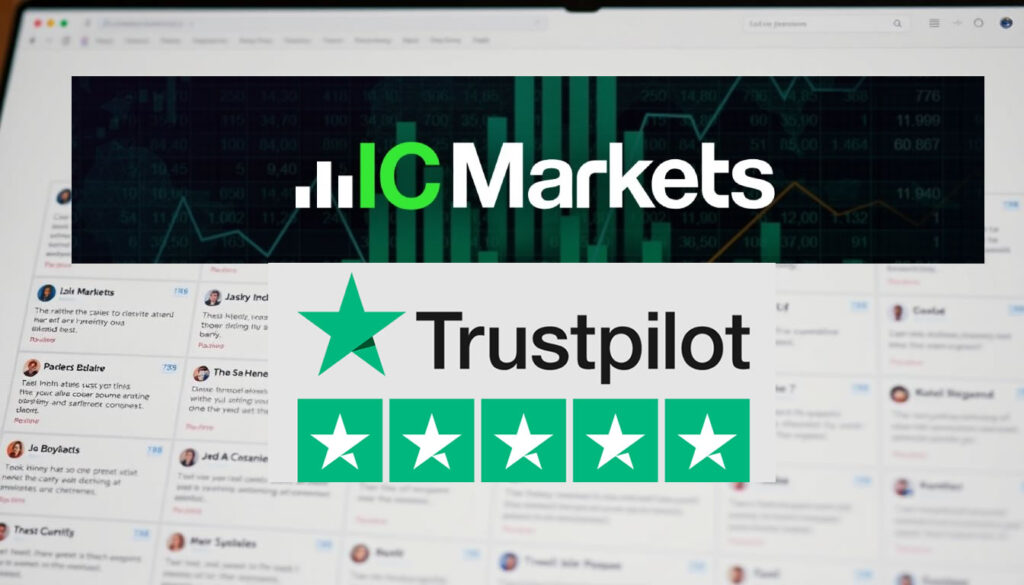Since its launch in 2007, this global brokerage has become a top choice for traders seeking advanced tools and reliable execution. Regulated by authorities like ASIC and CySEC, it combines strict compliance with innovative solutions for modern investors.
The platform stands out with over 3,500 tradeable assets, including currency pairs, commodities, and cryptocurrencies. Servers in London and New York ensure lightning-fast order processing, critical for strategies requiring precision timing.
Algorithmic traders particularly benefit from the infrastructure designed for high-frequency operations. Monthly volumes exceeding $1.39 trillion showcase its popularity among serious market participants worldwide.
This analysis explores account options, platform features, and client support tailored for British traders. Whether you’re new to currency markets or an experienced professional, understanding a broker’s strengths helps align services with personal goals.
An Overview of IC Markets UK
Operating across key financial hubs, this brokerage prioritizes institutional-grade infrastructure for serious market participants. Its multi-entity structure spans Cyprus, Australia, and Seychelles, offering traders access to global liquidity pools while adhering to strict regulatory standards.
The platform specializes in agency execution models, connecting users directly with top-tier liquidity providers. This setup removes conflicts of interest common in retail-focused brokers, ensuring transparent pricing for forex pairs and other assets.
Three core platforms dominate the offering:
- MetaTrader 4/5 for automated strategies
- cTrader for advanced charting
- Proprietary tools for speed optimization
With 260 specialists supporting operations, the firm handles complex trading scenarios effortlessly. Over 80% of clients use algorithmic systems, benefiting from sub-millisecond execution speeds across 40+ currency pairs.
While beginners might find the environment challenging, experienced traders appreciate features like:
- Raw spreads from 0.0 pips
- Unlimited order volumes
- API integration capabilities
The focus remains on delivering professional-grade solutions rather than basic retail perks. This approach has cemented its reputation among those who treat trading as a primary income source.
A Deep Dive into the Regulatory Framework

Understanding a broker’s regulatory status helps traders manage risk effectively. Three entities oversee operations under distinct frameworks, offering varying protection levels for different market participants.
Tier Rankings and Licensing Bodies
CySEC (License 362/18) and ASIC (License 335692) provide Tier-1 oversight. These regulators enforce strict capital requirements and regular audits. European traders benefit from MiFID II compliance, while Australian accounts follow ASIC’s client money rules.
The Seychelles FSA (License SD018) operates as a Tier-3 regulator. This allows higher leverage up to 1:500 but offers fewer investor safeguards. Retail traders under CySEC/ASIC get 1:30 leverage caps under classification rules.
Segregated Funds and Negative Balance Protection
All entities keep client funds in separate bank accounts. This prevents commingling with corporate assets, reducing risk during financial instability. CySEC and ASIC clients receive automatic negative balance protection.
Compensation differs across regions:
- €20,000 through Cyprus’ Investor Compensation Fund
- $1 million insurance for Seychelles-based accounts
Australian retail traders should note CFDs lack National Guarantee Fund coverage. These layered safeguards demonstrate how regulatory frameworks adapt to regional market demands while prioritizing capital security.
Exploring Account Types and Minimum Deposit Requirements

Selecting the right brokerage account requires matching platform features with personal trading strategies. Three primary options cater to varying needs: Standard, Raw Spread, and cTrader Raw Spread accounts. Each maintains a $200 minimum deposit, creating equal entry points for traders with different budget sizes.
Standard Account Features
The Standard account simplifies cost calculations with spread-only pricing. Major pairs like EUR/USD average 0.8 pips, ideal for newcomers or those preferring predictable expenses. No commission charges make this option particularly attractive for occasional traders.
Raw Spread and cTrader Account Insights
Active traders often favor Raw Spread accounts for their 0.6 pip starting spreads. A $7 commission per trade offsets the tighter pricing, benefiting those executing frequent orders. The cTrader variant mirrors this structure but reduces fees to $6, specifically optimized for users of that platform’s advanced tools.
All account types provide identical market access and withdrawal processes. The choice hinges on trading frequency and cost preferences – spread-focused models suit casual users, while commission-based options reward high-volume activity. This flexibility ensures both novice and experienced traders find suitable conditions within the same brokerage environment.
Trading Platforms and Tools at IC Markets UK

Modern traders demand versatile platforms that adapt to diverse strategies. The brokerage delivers four professional-grade systems: MetaTrader 4, MetaTrader 5, cTrader, and TradingView. Each solution caters to specific needs, from automated execution to collaborative analysis.
MetaTrader 4 and MetaTrader 5 Capabilities
MT4 and MT5 remain industry standards for automated trading. Users access 9 timeframes, 30 technical indicators, and custom Expert Advisors. The Advanced Trading plugin supercharges these platforms with 20 specialized tools for precision order execution and real-time market insights.
cTrader, TradingView, and Additional Plugins
cTrader shines with Level II pricing and 70+ charting instruments. Its copy trading feature lets users mirror successful strategies seamlessly. TradingView integration unlocks social trading communities and 100+ technical indicators for crowd-sourced analysis.
Third-party plugins expand analytical firepower:
- Autochartist scans markets for chart patterns automatically
- Trading Central provides institutional-grade research reports
Qualified traders receive free VPS hosting, reducing latency to 5 milliseconds for algorithmic systems. Mobile apps maintain full functionality, letting users manage positions across devices without compromising speed or features.
Order Execution and Trading Speed Advantages

Speed defines success in modern financial markets. The broker achieves 40-millisecond average execution speeds through servers in New York’s Equinix NY4 and London’s Equinix LD5 data centers. This strategic placement minimizes distance delays between major liquidity hubs.
Through an ECN model, traders connect directly to multiple liquidity providers. This setup removes conflicts of interest and ensures transparent pricing. Orders execute at the best available prices without requotes – critical for time-sensitive strategies like scalping.
High-frequency systems thrive here. Free VPS hosting slashes latency to under 5 milliseconds for algorithmic trading. Servers co-located with exchange gateways enable rapid trade execution even during volatile periods.
Three factors create this edge:
- Direct market access via Tier-1 banks
- Optimized network routing between key financial cities
- No dealing desk interference
The platform handles 1.5 million trades daily without slowdowns. Whether trading currencies during London sessions or indices at New York open, execution consistency remains paramount. This infrastructure supports strategies where milliseconds impact profitability.
Fee Structures, Spreads, and Commission Analysis

Cost efficiency remains paramount in successful trading strategies. This section breaks down pricing models that impact profitability across different account types and trading styles.
Competitive Spreads Across Asset Classes
The platform delivers razor-sharp spreads that consistently beat industry averages. EUR/USD starts at 0.8 pips on Standard accounts, tightening to 0.6 pips for Raw account holders. Testing reveals even better performance during peak hours.
Precious metals traders gain significant advantages. Gold spreads average 15 pips versus 42 pips elsewhere. GBP/JPY operates at 1.2 pips – less than half the 2.44 pip sector standard. These price advantages apply across forex, commodities, and indices.
Commission Comparison With Industry Benchmarks
Raw accounts use transparent commission models. MetaTrader users pay $7 per standard lot round turn, while cTrader traders get $6 rates. Both options remain below typical $8-10 charges seen at competing brokers.
High-volume traders receive discounts exceeding 30% for executing 100+ lots monthly. Zero deposit/withdrawal fees and no inactivity charges further enhance cost efficiency. Third-party payment processors may apply separate fees depending on method.
Overnight trading costs align with market norms. Swap rates for holding positions mirror interbank benchmarks, making longer-term strategies viable without excessive carrying expenses.
Diverse Tradable Instruments and Market Offerings

A broad spectrum of assets allows investors to craft portfolios aligned with their risk tolerance and market outlook. Over 3,500 instruments span traditional securities and cutting-edge digital assets, providing tools for strategic diversification across global exchanges.
Forex, Commodities, and Indices
Currency traders access 61 forex pairs, from major EUR/USD trades to exotic combinations. Precious metals like gold and energy products such as Brent crude complement 25 commodity options. Index enthusiasts trade 25 global benchmarks, including the FTSE 100 and NASDAQ Composite.
CFDs, Cryptocurrencies, and Bonds
Over 2,100 share CFDs cover European, American, and Asian equities. Cryptocurrency traders choose among 21 digital assets like Bitcoin and Ethereum with competitive spreads. Fixed-income investors diversify with nine government bonds and four futures contracts.
This multi-asset approach supports strategies ranging from short-term speculation to long-term hedging. Whether reacting to economic data or anticipating sector trends, traders find instruments matching their market perspective and risk parameters.



